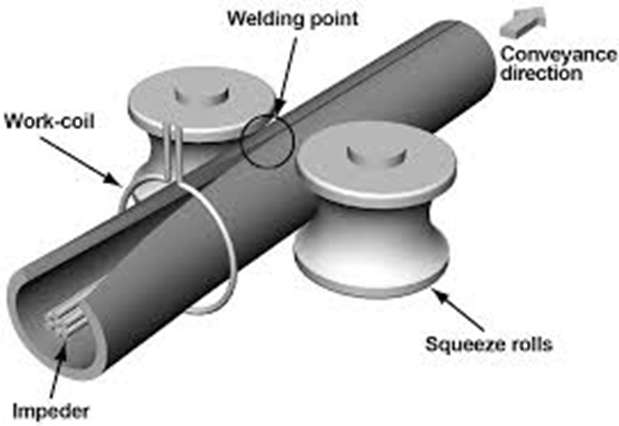"ERW steel pipe" is a high-frequency straight seam resistance welded pipe, abbreviated as ERW, used to transport oil, natural gas and other vapor and liquid objects, can meet various requirements of high and low pressure, currently in the world The field of management occupies a pivotal position.
ERW steel pipe is a "high-frequency resistance welded steel pipe", which is different from the welding process of ordinary welded pipe. The weld is formed by melting the base material of the steel strip body, and its mechanical strength is better than that of general welded pipe.

ERW Pipes and Tube Manufacturing Process:
In the Electric resistance welded (ERW) manufacturing process, the pipe is manufactured by cold-forming a flat sheet of steel into a cylindrical shape. Then the current is passed between the two edges of the steel to heat the steel to a point at which the edges are forced together to form a bond without welding filler material.

ERW stands for electric resistance welding. Electric resistance welding has the characteristics of high production efficiency, low cost, material saving, and easy automation. Therefore, it is widely used in aviation, aerospace, energy, electronics, automotive, light industry and other industrial sectors. It is one of the important welding processes.
The biggest difference between ERW steel pipe and
seamless steel pipe is that ERW has a weld, which is also the key to the quality of ERW steel pipe. Some people divide the seamlessness of ERW steel pipe into geometric seamlessness and physical seamlessness. Geometric seamlessness is Remove the internal and external burrs of ERW steel pipes. Due to the continuous improvement and perfection of the structure of the internal burr removal system and tools, the removal of burrs in large and medium diameter steel pipes has been better processed. The internal burrs can be controlled within -0.2mm~O.5mm. Physical seamlessness refers to the difference between the metallographic structure inside the weld and the base metal, which causes the mechanical properties of the weld area to decrease, and measures need to be taken to make it uniform and consistent. High-frequency welding heat process of ERW steel pipe caused the temperature distribution gradient near the edge of the tube blank, and formed characteristic areas such as melting zone, semi-melting zone, superheated structure, normalizing zone, incomplete normalizing zone, and tempering zone. Among them, the superheated zone structure is due to the welding temperature. Above 1000℃, the austenite grains grow up sharply, and will form hard and brittle coarse crystal phases under cooling conditions. In addition, the existence of temperature gradients will produce welding stress. In this way, the mechanical properties of the weld zone are better than those of the base material. In the low case, the physical seamlessness is to use the local conventional heat treatment process of the weld to heat the weld area to AC3 (927°C) with an intermediate frequency induction heating device, and then perform an air cooling process with a length of 60m and a speed of 20m/min. Water cooling. The use of this method achieves the purpose of eliminating stress, softening and refining the structure, and improving the comprehensive mechanical properties of the welding heat-affected zone. At present, the world's advanced ERW unit has generally adopted this method to process the weld. Good results are obtained. The high-quality ERW steel pipe not only cannot distinguish the weld, but also the weld coefficient reaches 1, which realizes the match between the weld area and the base material.
ERW steel pipe has the advantages of using hot-rolled coil as raw material, the uniform wall thickness can be controlled at about ±0.2mm, the two ends of the steel pipe are in accordance with the American Apl standard or GB/T9711.1 standard, the end is beveled, and the length is delivered. Advantages. In recent years, various natural gas pipeline network projects and gas companies have widely adopted ERW steel pipes as the main steel pipes of urban pipe networks.
Read more: ERW Steel Pipe Manufacturing Process or ERW pipe vs. HFW pipe



